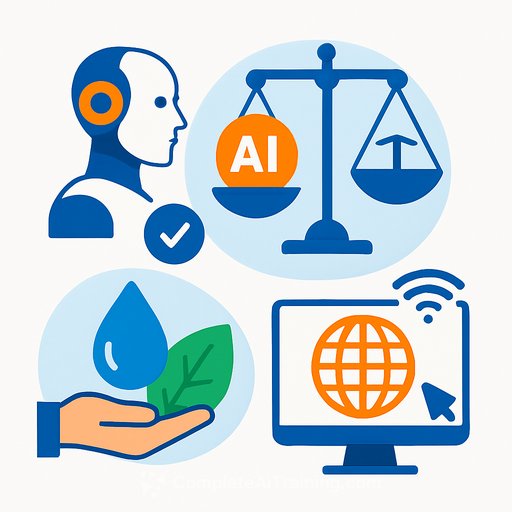Pilots will grow up in 2026: Behavioral health AI moves into core operations
Behavioral health leaders are done tinkering on the edges. Andy Flanagan, CEO at Iris Telehealth, and Dr. Tom Milam, the company's chief medical officer and a practicing psychiatrist, say the next 12 months are about turning pilots into production. The focus: use AI to triage demand, protect capacity and speed access - without stepping into clinical decision-making.
The shift: from experiments to essential ops
Many health systems have run isolated pilots to "see what AI can do." That phase ends in 2026. As Milam puts it, AI will become an essential operational tool that helps programs spot who needs help first and route limited resources accordingly.
The strategic distinction matters. AI in behavioral health should target operational efficiency - scheduling, resource allocation and access - not diagnosis or treatment planning. That's where the technology delivers value without compromising safety.
Where AI fits (and where it doesn't)
These models are probability engines. They find patterns in operational and utilization data and surface timely recommendations. They are not a substitute for clinical judgment.
Human-in-the-loop remains non-negotiable. In a recent Iris Telehealth survey of 1,000 U.S. consumers, 73% want human providers to make final calls in AI-flagged emergencies. Keep AI as a support tool, and you keep trust - and safety - intact.
Primary use case: intake and scheduling triage
Traditional access is reactive: callers are scheduled based on availability, then wait weeks or months. AI flips that model by prioritizing by risk and need.
- Data signals: appointment history, no-show rates, recent ED visits, utilization patterns, patient-reported concerns.
- Outcome: a ranked list by urgency, so schedulers answer the real question - "Given capacity for 100 visits this week, which 100 patients have the highest need?"
- Effect: shorter time-to-first-visit for high-acuity patients, fewer ED recidivism cycles, better use of scarce clinician time.
Proof points from leading centers
Some academic medical centers are already moving from pilots to clinics. Duke University School of Medicine received a $15 million grant from the National Institute of Mental Health to scale an AI model that predicts worsening mental health up to a year in advance with reported 84% accuracy, extending into rural sites across North Carolina, Minnesota and North Dakota. For context on research priorities, see the NIMH funding programs.
A 90-day operational playbook
If you're ready to graduate pilots, this is a practical path that keeps risk low and value high.
- Define one problem: reduce wait time for high-need patients by X% without increasing no-shows.
- Choose inputs you already capture: no-shows, ED visit flags, prior cancellations, acuity from intake forms, payor or coverage changes.
- Build a simple risk score: start with interpretable models (logistic regression or gradient boosting) and clear features.
- Insert into workflow: surface the score in your EHR workqueue; let access teams sort by "Urgency" instead of "Date requested."
- Capacity guardrails: reserve a percentage of slots each day/week for high-urgency patients.
- Human review: triage nurses or care coordinators confirm AI flags before rescheduling or outreach.
- Feedback loop: capture "overrides" and missed flags to retrain the model monthly.
- Start small: one clinic or service line, two schedulers, two clinicians; run an A/B for 4-6 weeks.
Governance and safety
- Clear boundaries: AI assists with prioritization and outreach; clinicians make care decisions.
- Policy: define escalation for any crisis signal - human review within set SLAs.
- Bias checks: monitor performance by age, race, language, payer, and geography.
- Security: PHI minimization, audit trails, and vendor BAAs; restrict prompts and outputs to operational data.
- Patient communication: simple scripts for why an appointment was moved up (or held) to set expectations and reduce complaints.
Integration basics (no heavy lift required)
- Data flow: nightly batch scoring from the data warehouse; optional real-time scoring via FHIR API at intake.
- Surfacing: a single risk column in existing workqueues; color-coded flags; zero new apps for front-line staff.
- Change management: 60-minute training for schedulers and care coordinators; weekly huddles for the first month.
Metrics that matter
- Time-to-first-visit by risk tier (goal: high-tier under 7-10 days).
- No-show rate and late-cancellation rate by tier.
- ED recidivism within 30 days post-intake.
- Clinician utilization and schedule density (reduce gaps and overbooking).
- Percentage of capacity allocated to high-urgency patients vs. baseline.
- Override rate and reasons (feeds model improvement and policy updates).
What to avoid
- Letting the model make clinical calls. Keep it out of diagnosis and treatment planning.
- Deploying system-wide on day one. Prove it in one service line, then scale.
- Black boxes you can't explain to clinicians, legal, or patients.
The bottom line
Pilots taught us what's possible. 2026 is about disciplined execution: use AI to prioritize access, protect scarce clinician time and reduce avoidable crises. Keep a human in the loop, measure what matters and resist the urge to overreach into clinical territory. Do that, and your program gets faster, safer and fairer at the same time.
If your operations team needs structured upskilling to support these initiatives, explore practical AI courses by role at Complete AI Training.
Your membership also unlocks:










